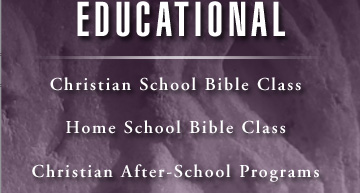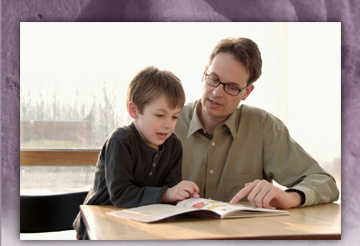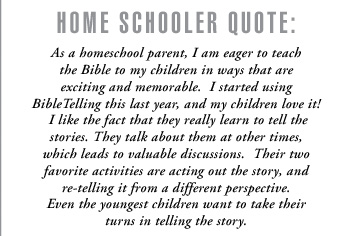 |
Seven-step Plan for Learning a Bible Story without
Memorizing
Students are usually cooperative in going through this process because they
realize they need to learn the story. On Friday, they are going to stand in
front of a younger class and tell the story.
- The new Bible story is presented using the CD.
Most teachers do not tell the story themselves because they do not have the
time to learn the story in advance. Many choose to learn the story with
the class.
- Students learn the storyboard for the story.
A storyboard is a series of mental pictures and hand gestures that help a
person learn the overall structure of the story. The storyboards are provided
in the book. Eventually students create their own.
- Several students rehearse the storyboard with the
help of the class.
Storyboards are usually divided into three sections. Three different students
volunteer to illustrate one section each.
- Each student practices the storyboard with a partner.
They should practice the storyboard together, instead of taking turns.
- Students listen to the Bible story a second time.
Because of the storyboard, the class can “see” the story as well
as hear it.
- Each student tells the story to a partner.
• As
soon as
students
have heard
the story
the second
time, they
immediately
turn to
their partners
and tell
the story.
• They
should
tell the
story in
their own
words the
best they
can.
• This
is called “stumbling
through
the story.” The
telling
of the
story will
improve
as the
week goes
by.
• Students
should
not embellish
the story
any more
than it
has been
embellished
on the
CD.
- Students draw the storyboard.
A page is provided in the book for the students to draw the storyboard. They
can use stick figures, words, outline, or elaborate drawings. This activity
can be assigned as homework.
Class Discussion
Christian School Bible classes are made up of students with
a variety of backgrounds, learning differences, and various levels
of Bible knowledge. Still, it is important to engage everyone
in the discussion. Therefore the following rule is recommended
for the most effective Biblical learning:
 No
other
part
of
the
Bible
can
be
discussed
except
the
story
of
the
week
and
previous
stories. No
other
part
of
the
Bible
can
be
discussed
except
the
story
of
the
week
and
previous
stories.
We recommend the following three discussion questions.
- “What does this story teach us about God?”
As the class goes from story to story, the students will grow in their knowledge
of God and how He relates to people. This understanding of God will grow
naturally as they see His story unfold.
- “What does this story teach us about people?”
Bible stories offer a great study in human nature. An alternate question
would be “What does this story teach us about the people of God?”
- “What is your favorite part of the story, and why?” This
is an important question because it allows students the opportunity
to express their interest in the story, and it stimulates lively
discussion.
Story Activities
When teaching BibleTelling, Christian School Bible teachers
want their students to learn the stories, but they also want
the stories to become personally meaningful. This is only accomplished
when the teacher allows for various learning preferences, and
students are able to communicate the story in their most enjoyable
way of expression. This moves the Biblical story down from the
head and firmly implants it into the heart.
Each BibleTelling lesson provides activities ideas that encourage
students to personalize the stories. Each student, or group of
students, choose from the following multidimensional learning
activities:
Drama
Music
Poetry
Art
Crafts
Research
Writing |
Games
Foods
Storytelling
Pantomime
Demonstration
Sign Language
Discussion/Debate |
Outdoors/Nature
Logic/Math
Group Interaction
Outlines/Charts/Graphs
Construction/Building
Physical Movement
Character Analysis |
As students go through BibleTelling, they tend to follow a pattern.
They start by using one of the easiest activities provided in
the book. Quickly they will move to the more difficult ones that
look interesting to them. Finally they will ignore the list completely
and develop their own ideas.
Cost of Materials
Schools have several price options when buying BibleTelling
materials. Each book contains nine stories and is one quarter
of the course. There are four books per year (36 stories total).
- The retail price for each book is $19.95
w/the CD,
and $14.95 per book w/o the CD.
The website special is $14.95 including CD.
- A case lot (36 books) price is $9.97 per
book w/o CD.
The website special is $9.97 including CD, but not placed inside the books.
Introductory offer – you
may “mix/match” the books in your
case.
Here are some of the comments from teachers and students:
- teacher – “I told my class we were having a
short week the following week. I suggested we just have a study
hall. They said, ‘No, we want to learn the next story!’ I
have never had a group of students enjoy Bible class so much.”
- student – “I like it because we actually have
to learn the material instead of just passing a test”
- teacher – “My students are volunteering eight
weeks in advance to tell these stories for our Awana Clubs.”
- student – “Since we tell the Bible stories to
younger students, they start associating the stories with us.
Now we have to watch how we live, because we know they are
watching us.”
- teacher – “The kids work hard in this class,
yet they enjoy it. It is the best Bible course we have ever
used.”
Home School Bible Class | top
of page |
BibleTelling makes a Home School Bible class totally interactive,
and it can include the entire family. It also has a great impact
on the daily lives of each family member.
It turns the Bible class into an interesting and productive
class. Young people and children do not simply sit and listen
to you teach about the Bible. Instead, they learn to tell the
stories of the Bible themselves and participate in activities
that bring the Bible into their frame of reference.
- At the end of the first year, they have learned and told
36 Bible stories. They also know the overall structure of the
Old Testament.
- In the second year, they learn to tell 36 stories from the
Life of Christ, making a total of 72 stories for both years.
- In the third year, they learn to tell an additional 36 stories
from the Old Testament, stories that focus on faith and character.
This makes a total of 108 stories for the three years.
- In the fourth year, they learn to tell 36 stories from the
Book of Acts, making a total of 144 stories for all four years.
- Four years of BibleTelling gives students a better grasp
of Scripture than most Bible College graduates have.
***** As a home school parent, you will also greatly increase
your knowledge of Scripture!
Typical Five-Day Bible Class Schedule
- Monday – Your students learn the story using
the “seven-step plan”
- Tuesday – The family discusses the story and then
selects activities according to each person’s learning
preference. Another option would be to select an activity that
includes the younger children.
- Wednesday – This day is given over to preparing and
practicing the activity. Special art projects can be given
to younger students to enhance their involvement with the story.
- Thursday – The activities are presented or performed.
This could be:
 – for
a DVD camera – for
a DVD camera
 – for
a spouse not
as involved
in the – for
a spouse not
as involved
in the
 teaching
process teaching
process
 – for
neighbors or
grandparents – for
neighbors or
grandparents
- Friday and weekend – each of the older students tell
the story to an assigned group – Sunday school, children’s
club, retirement home, small group Bible study, etc.
Homework is given for the next story – Search the Scripture.
Here are some of the comments from parents, pastors,
and students:
- pastor – “Recently we had a young man come to
our church to raise money for a missions trip. His presentation
was full of wonderful stories and he told them so well. Most
young people don’t know how to communicate that well,
so I asked him about it. He told me he was taking BibleTelling
in his home school course, and it has influenced his storytelling
abilities. Our church was so impressed!”
- parent – “I like it because the students have
to learn the stories and not just pass the test”
- student – “I teach a Sunday school class. Now
I learn the story in my Bible class and I tell it to my Sunday
school class.”
Seven-step Plan for Learning a Bible Story without
Memorizing
Students become unusually cooperative in going through this process. They realize
they need to learn the story because by Friday, they have to be ready to tell
the story.
- The new Bible story is presented using the CD.
Most parents do not tell the story themselves because they do not have the
time to learn the story in advance. Many choose to learn the story with
their children.
- Students learn the storyboard for the story.
A storyboard is a series of mental pictures and hand gestures that help a
person learn the overall structure of the story. The storyboards are provided
in the book. Eventually students create their own.
- Several children rehearse the storyboard with the
help of the others.
Storyboards are usually divided into three sections. Ask different members
of your family to do each section.
- Each student practices the storyboard with another
family member.
They should practice the storyboard together, instead of taking turns.
- Students listen to the Bible story a second time.
Because of the storyboard, your children can “see” the story
as well as hear it
- Each student tells the story to another family member.
• As soon as they have heard
the story a second time, students immediately turn
to their partners and tell the story.
• They
should
tell the
story in
their own
words the
best they
can.
• This
is called “stumbling
through the
story.” The
telling of
the story
will improve
as the week
goes by.
• Students
should
not embellish
the story
any more
than it
has been
embellished
on the
CD.
- Students draw the Storyboard.
A page is provided in the book for the students to draw the storyboard. They
can use stick figures, words, outline, or elaborate drawing. This activity
can be assigned as homework.
Class Discussion
Because of the various levels of Bible knowledge within the family, and to
insure everyone can participate in the discussion, the following rule is
recommended for the most effective Biblical learning:
No other part of the Bible can be discussed
except the story of the week and previous stories.
There are the three discussion questions asked in the book:
- “What do we learn about God from this story?”
As the family goes from story to story, the children will grow in their knowledge
of God and how He relates to people. This understanding of God will grow
naturally as they see His story unfolds.
- “What do we learn about people from this story?”
Bible stories offer a great study in human nature. An alternate question
would be “What does this story teach us about the people of God?”
- “What is your favorite part of the story, and why?”
This is an important question because it allows your children the opportunity
to express their interest in the story, and it stimulates lively discussion.
Story Activities
When teaching BibleTelling, Christian parents want their children to learn
the stories of God. Still a Christian mother or Christian father wants these
stories to become personally meaningful to their children. This is only accomplished
when people communicate the story in their most enjoyable way of expression. This
moves the Biblical story down from the head and firmly implants it into the
heart.
Each BibleTelling lesson provides activities ideas that encourage
students to personalize the stories. Each child (or the family
as a whole) will choose from the following:
Drama
Music
Poetry
Storytelling
Pantomime
Demonstration
Sign Language |
Art
Crafts
Research
Discussion/Debate
Outdoors/Nature
Logic/Math
Group Interaction |
Writing
Games
Foods
Outlines/Charts/Graphs
Construction/Building
Physical Movement
Character Analysis |
As students go through BibleTelling, they tend to follow a pattern.
They start by using one of the easiest activities provided in
the book. Quickly they will move to the more difficult ones that
look interesting to them. Finally they will ignore the list completely
and develop their own ideas.
Cost of Materials
Home School parents have several price options when buying
BibleTelling materials. Each book contains nine stories and is
one quarter of the course. There are four books per year (36
stories total).
- The retail price for each book is $19.95
w/the CD, and $14.95 per book w/o the CD.
The website special is $14.95 including CD.
- A case lot (36 books) price is $9.97 per
book w/o CD.
The website special is $9.97 including CD, but not placed inside the books.
Introductory offer – you may “mix/match” the books in your
case.
This is ideal for a home school support group.
Comments from Parents Using the Program
— coming attraction —
Christian After-School
Programs | top of page |
There are many churches and Christian organizations that offer
a program for children after they are out of school for the day,
and before their parents are able to pick them up. BibleTelling
is excellent for an after-school Bible class. It teaches the
stories to the young people and they tell the stories at home.
Follow the instructions found in the Christian School page
under the Education section of this website.
|
 |





